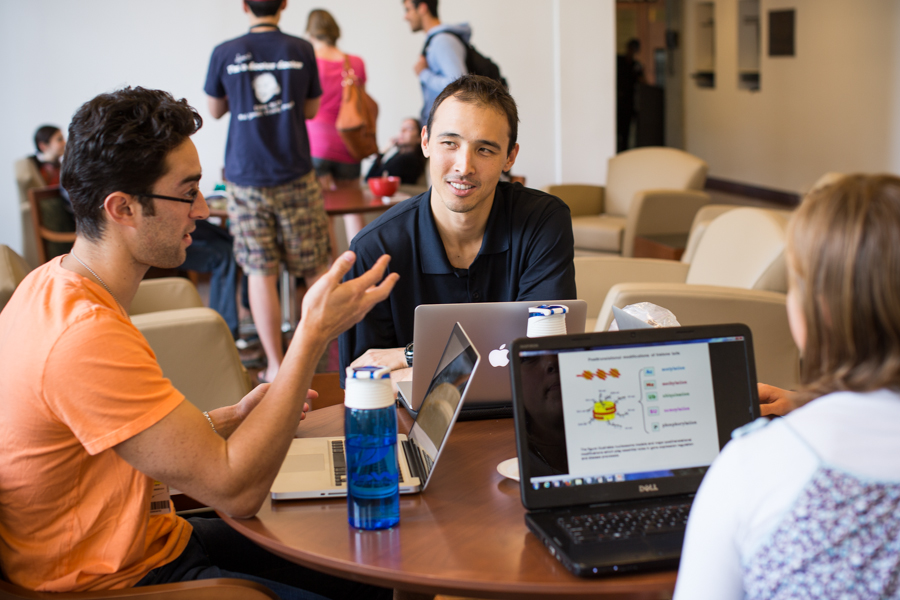
Active learning at Einstein: Students collaborate on educational projects
Editors’ Note: According to the AAMC, more than 80,000 students are currently enrolled in U.S. medical schools. Without question it’s a pivotal time in medical education. Expectations of physicians-in-training are shifting. Doctors must not only be able to demonstrate sharp clinical skills but also be digitally literate and humanistic.
In April, we dedicated the entire month to applying to and succeeding in medical school. Beginning this month, we launch a series of blog posts focused on increasing active learning and promoting more effective teacher-student engagement in medical education. Every Tuesday in September and periodically throughout the year, we’ll cover topics ranging from improving team learning to examining the role of digital technology in patient care. We’ll also detail Einstein’s own initiative to adjust educational competencies to produce the most skilled and compassionate clinicians.
We kickoff this series with a look at the critical impact that physical space can have on teaching, learning and solving problems through collaboration.
by MARTHA S. GRAYSON, M.D.
Our dean recently had the vision to create a new education center and asked me to lead a task force. When first asked, my inner designer assumed that it would be a relatively simple task, choosing paint colors and furniture finishes and deciding where strategically to place all the outlets needed so that our “plugged in” millennial students could always be connected.
Besides that, what more was there to do? We already have an incredibly talented and knowledgeable faculty, women and men who not only deliver first-class lectures here at Einstein but also are frequently asked to lecture around the nation and the world.
I quickly took a step back and the educator in me realized that we had better do what is necessary for any new educational project: conduct a “needs assessment,” query our faculty and students about current and future teaching needs, examine new standards for accreditation and licensure, speak with experts and investigate best practices for education space around the country. We brought in an outside expert to set the stage for these conversations with a presentation to our task force on current trends in education-space design.
There has been a distinct change in the way we educate physicians today, one that fosters lifelong learning, teamwork, communication skills and critical thinking. Adult learners do best when allowed to engage actively with materials, when they can discuss, explore, analyze, challenge and collaborate.
While our educational programs at Einstein have been at the forefront of these new trends, our education space to promote this type of learning has decidedly fallen short.
After much due diligence, our task force came to an emphatic conclusion: the design of education space really does matter—and not for aesthetic reasons alone. It can have a significant impact on learning.
Our traditional lecture halls, similar to many across the country, are designed with fixed seats, furniture and dimensions that have all learners facing forward toward the instructor, an instructor who becomes the “sage on the stage,” delivering content—determined in advance—to all students. This type of layout does not foster the spirit of inquiry and interpersonal skills that future physicians serving the healthcare needs of society must have.
Our task force had lively discussions about all aspects of our “dream” education space. We deliberated over the size and shape of rooms, the appropriate level of soundproofing (quiet vs. energetic) and the movability of walls. The discussions about the number of seats at a table proved to be the most heated. Who knew that faculty members could be so adamant that a table should seat no more than five, or that a table must seat a minimum of eight? In the end, we came to a truce and decided on round tables that comfortably seated groups of six.
Our engineering and facilities management department played a key role in this process, drawing up countless architectural plans based on our discussions.
As one can imagine in 2013, much of the discussion focused on technology, as education in the modern era takes place both in the classroom and outside, enabled by advances in software and devices.
In the end, we came up with our vision for Einstein, one that allows for education in three distinct designs of active learning “studios”:
- large-group learning;
- small-group learning; and
- theater-based educational events.
The common theme is that all these spaces champion interactive techniques that promote adult learning in a flexible and technology-rich environment. The combined studios will be able to seat more than 400 students and faculty, and roughly 14,000 square feet will be used.
Our faculty is enthusiastic about the plans to move forward, as these state-of–the-art spaces will allow us to continue to innovate and transform our educational program at Einstein, fostering the intellectual challenge and spirit of inquiry that are essential for physicians practicing in the modern world of medicine.
The process has been exciting; it has driven educational innovation in a whole new way here. Now back to choosing those paint colors!

